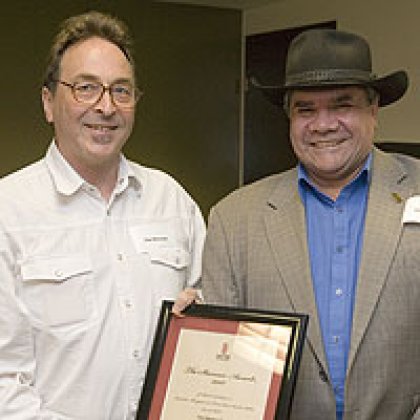
Paul Memmott’s acclaimed book Gunyah, Goondie + Wurley has been recognised by the Australian Institute of Aboriginal and Torres Strait Islander Studies, recently taking out the prestigious Stanner Award.
The UQ Professor published the book in 2007 and travelled to Canberra last month to receive the accolade, which applauds the most outstanding scholarly work in Aboriginal and/or Torres Strait Islander Studies for the calendar year.
The book is the first anthropological work to detail Australian Aboriginal architecture and turns on its head the belief that Indigenous people were devoid of houses or towns when Europeans first reached Australian shores.
The Director of UQ's Aboriginal Environments Research Centre (AERC), Professor Memmott's interest in the area began while working with Indigenous communities in North-west Queensland during the early 1970s as an undergraduate architecture student.
Gunyah, Goondie + Wurley includes contributions from Aboriginal authors as well as fellow AERC staff and postgraduates. The book is written for both academic and general readers and includes hundreds of photos, maps and illustrations.
Professor Memmott thanked the Australian Institute of Aboriginal and/or Torres Strait Islander Studies for the award.
“I hope Gunyah, Goondie + Wurley might yet inspire its readers to engage in other constructive and ambitious applied-research projects based on a fundamental respect of ancient Aboriginal knowledge,” he said.
The book has sparked two research projects including a call for a cross-cultural theory of architecture of the Western World, which includes buildings designed and built by non-architects or ethno-architects.
The second project stems directly from the book and is an Australian Research Council study into design prospects on Spinifex grasses, carried out in collaboration with the Dugalunji Aboriginal Corporation at Çamooweal in far Western Queensland, (on the Northern Territory border) where Professor Memmott is establishing an Arid Zone Research Field Station on behalf of The University of Queensland.
“There are a number of instruments and environmental sensors in several Spinifex clad domes at Camooweal, positioned to measure their thermal insulation performance in the domes built by East Arrernte, Indjiladji and Alyawarr Elders,” Professor Memmott said.
“Not far away is a set of 25 square Spinifex plots where a Muruwari postgraduate student is conducting burning, harvesting and re-growth experiments.
“One of the ultimate aims of this project is to see whether some possible sustainable use might be put to the 67 Spinifex grasses that cover conservatively a third of the Australian continent and whether a cottage industry could therefore be catalysed for Aboriginal outstations to sustainably farm their own Spinifex, either for local rural needs or for metropolitan commercial uses.”
The Stanner Award is the third national award won by Gunyah, Goondie + Wurley. This successful book has just undergone its first re-print.
Media: Paul Memmott (3365 3660, p.memmott@uq.edu.au) or Eliza Plant at UQ Communications (07 3365 2619)
.jpg)


